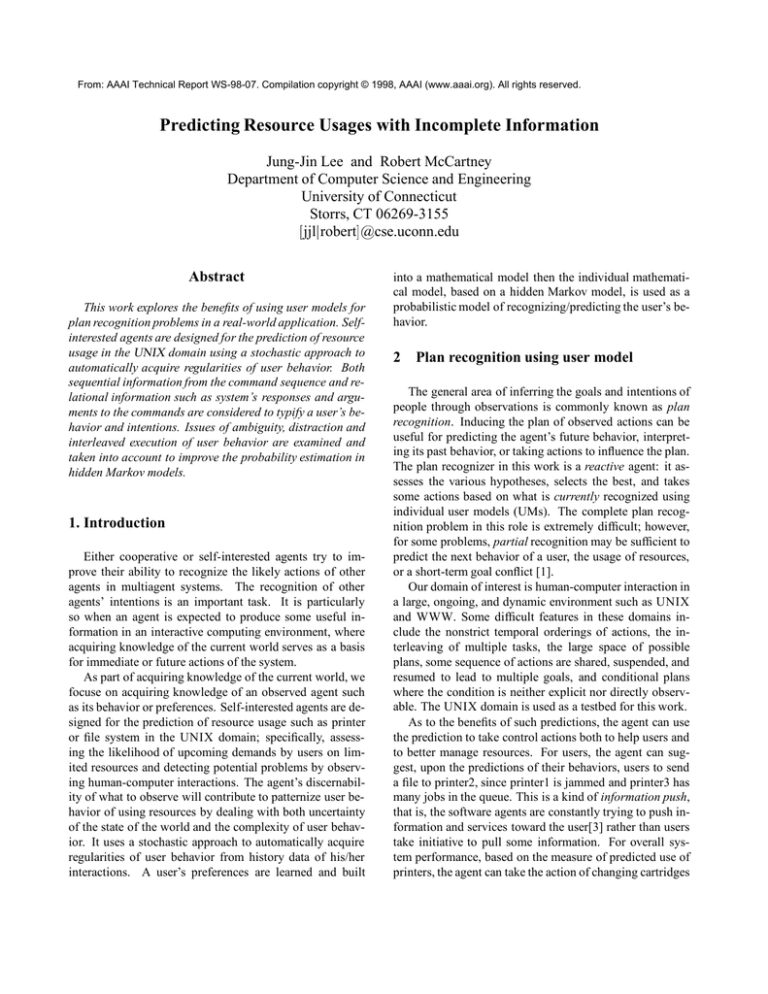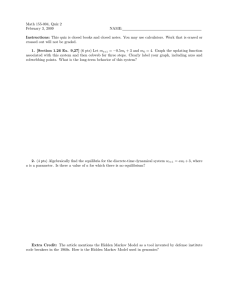
From: AAAI Technical Report WS-98-07. Compilation copyright © 1998, AAAI (www.aaai.org). All rights reserved.
Predicting Resource Usages with Incomplete Information
Jung-Jin Lee and Robert McCartney
Department of Computer Science and Engineering
University of Connecticut
Storrs, CT 06269-3155
[jjljrobert]@cse.uconn.edu
Abstract
This work explores the benefits of using user models for
plan recognition problems in a real-world application. Selfinterested agents are designed for the prediction of resource
usage in the UNIX domain using a stochastic approach to
automatically acquire regularities of user behavior. Both
sequential information from the command sequence and relational information such as system’s responses and arguments to the commands are considered to typify a user’s behavior and intentions. Issues of ambiguity, distraction and
interleaved execution of user behavior are examined and
taken into account to improve the probability estimation in
hidden Markov models.
1. Introduction
Either cooperative or self-interested agents try to improve their ability to recognize the likely actions of other
agents in multiagent systems. The recognition of other
agents’ intentions is an important task. It is particularly
so when an agent is expected to produce some useful information in an interactive computing environment, where
acquiring knowledge of the current world serves as a basis
for immediate or future actions of the system.
As part of acquiring knowledge of the current world, we
focuse on acquiring knowledge of an observed agent such
as its behavior or preferences. Self-interested agents are designed for the prediction of resource usage such as printer
or file system in the UNIX domain; specifically, assessing the likelihood of upcoming demands by users on limited resources and detecting potential problems by observing human-computer interactions. The agent’s discernability of what to observe will contribute to patternize user behavior of using resources by dealing with both uncertainty
of the state of the world and the complexity of user behavior. It uses a stochastic approach to automatically acquire
regularities of user behavior from history data of his/her
interactions. A user’s preferences are learned and built
into a mathematical model then the individual mathematical model, based on a hidden Markov model, is used as a
probabilistic model of recognizing/predicting the user’s behavior.
2
Plan recognition using user model
The general area of inferring the goals and intentions of
people through observations is commonly known as plan
recognition. Inducing the plan of observed actions can be
useful for predicting the agent’s future behavior, interpreting its past behavior, or taking actions to influence the plan.
The plan recognizer in this work is a reactive agent: it assesses the various hypotheses, selects the best, and takes
some actions based on what is currently recognized using
individual user models (UMs). The complete plan recognition problem in this role is extremely difficult; however,
for some problems, partial recognition may be sufficient to
predict the next behavior of a user, the usage of resources,
or a short-term goal conflict [1].
Our domain of interest is human-computer interaction in
a large, ongoing, and dynamic environment such as UNIX
and WWW. Some difficult features in these domains include the nonstrict temporal orderings of actions, the interleaving of multiple tasks, the large space of possible
plans, some sequence of actions are shared, suspended, and
resumed to lead to multiple goals, and conditional plans
where the condition is neither explicit nor directly observable. The UNIX domain is used as a testbed for this work.
As to the benefits of such predictions, the agent can use
the prediction to take control actions both to help users and
to better manage resources. For users, the agent can suggest, upon the predictions of their behaviors, users to send
a file to printer2, since printer1 is jammed and printer3 has
many jobs in the queue. This is a kind of information push,
that is, the software agents are constantly trying to push information and services toward the user[3] rather than users
take initiative to pull some information. For overall system performance, based on the measure of predicted use of
printers, the agent can take the action of changing cartridges
or warming up the printers or pull some information from
other agents. We look at three prediction problems: predicting next behavior considering only a previous action,
predicting the possibility of using resources with the partial sequence of actions observed, and predicting which resource is more likely to be used among competing ones.
3
W: source .login
A: ls
x .tex
y
B: vi x.tex
1 Abstract classes of actions are defined depending on the effects of
actions on files. For example, find class of actions has no effects on files but
gathers information such as ‘ls’ or ‘more’ and both ‘latex’ and ‘compress’
actions are a format class for actions of changing source files to destination
files and/or creating auxiliary files, etc.
B
C
A.C
A
D.D
L: more y
D.D
M: compress y
L
A.C
M
C: latex x.tex
Figure 1. Action sequence and correlations
Learning UM using machine learning
The user preference varies in detailed levels of actions
and a stochastic approach is taken to learn user models.
However, those actions share features: same abstraction,
shared subplans, or same goals. We use templates as abstractions of actions, to facilitate the explanation of a user’s
plan with procedural structures1. While each action can be
explained as an abstract class, some actions are optional
to complete a plan or shared by multiple plans which are
hidden from the observation. We use hidden Markov models (HMMs) to represent the ambiguity of actions towards
plans within underlying structure. Due to the simplicity and
efficiency of its parameter estimation algorithm, the HMM
has emerged for modeling discrete time series of stochastic processes and sequences and speech recognition[2]. In
the double embedded structure of this model, the outcomes
of user actions are observable random variables, called the
observation sequence, that each depend only on an underlying state variable (output probability). The hidden state
variables which represent plans in turn depend only on their
immediate predecessors (Markov chains).
Suppose the recognizing agent has two resources to manage: printer and router resources having three abstract
plans, namely, “Printing” plan, “SendingOff” plan, and
“Others” plan which pertains to actions other than actions
under the “Printing” and “SendingOff” plans. The plan
states are interconnected in such a way that any state can be
reached from any other state, and the underlying stochastic
process of the states has another set of stochastic processes
that produce the sequence of observations. The outcome
sequence depends very much on the parameter sets which
characterize the HMM: the individual bias(preferences) of
abstract plans, the transition probabilities between various
states(plans), as well as initial states chosen as the starting points of observations. In Fig. 1, the likelihood of a
partial sequence: fls, vi, latexg, based on their correlation, to be in a “Printing” plan given a model can be
computed with the sum of the joint probabilities, that is, the
product of individual state transitions and output probabilities of observable actions.
W
4
Acquisition of user knowledge
In command-driven systems like UNIX, observation of
action sequence only is not enough to acquire the knowledge of user behavior[4]. To typify a user’s behavior and intentions, relational information such as system’s responses
and arguments to the commands are considered besides sequential information from the command sequence. D.D.
and A.C. in Fig. 1 represent data dependency and argument
coherence rules respectively. In respect to learning user behavior, issues of ambiguity, distraction and interleaved execution are examined from the automatic analysis of recognizing shared actions, excluding extraneous actions related
to resouce use and finding correlations and disclosing hidden states and taken into account to improve the accuracy
of model parameters in HMMs. A graph-based analysis algorithm is used to disclose hidden states and shared actions.
5
Current status
The objective of this work is to develope a reactive agent
in a real-world application, solving plan recognition problems using user models. The work is still in a training phase
to produce reliable and stable models for predictions. A Perl
script is used for automatic on-line data collection, capturing both sequential and relational information. These data
are used for off-line analysis and evaluation of the predictions.
References
[1] J.J. Lee. Case-based plan recognition in computing domains,
(Doctoral Consortium), In Proceedings of the Fifth International
Conference on User Modeling pp. 234–236. Kailua-Kona, Hawaii
1996.
[2] L. Rabiner. A tutorial on hidden Markov models and selected
applications in speech recognition. In Proceedings of the IEEE,
vol. 77, No. 2, pp. 257–286, 1989.
[3] W. Van de Velde et al. Competition for Attention. in Preproceedings of the 4th Int., Workshop on Agent Theories, Architectures, and Languages, pp 282–296, Providence, RI. 1997.
[4] K. Yoshida and H. Motoda. Automated User Modeling for
Intelligent Interface. in Int. J. of Human Computer Interaction,
8(3):237–258, 1996.




